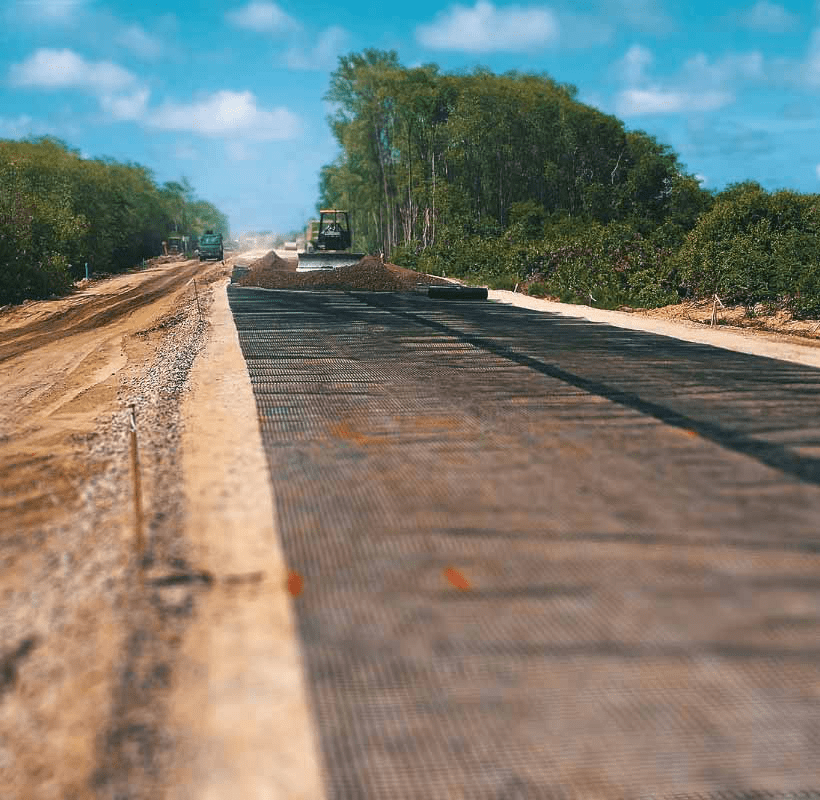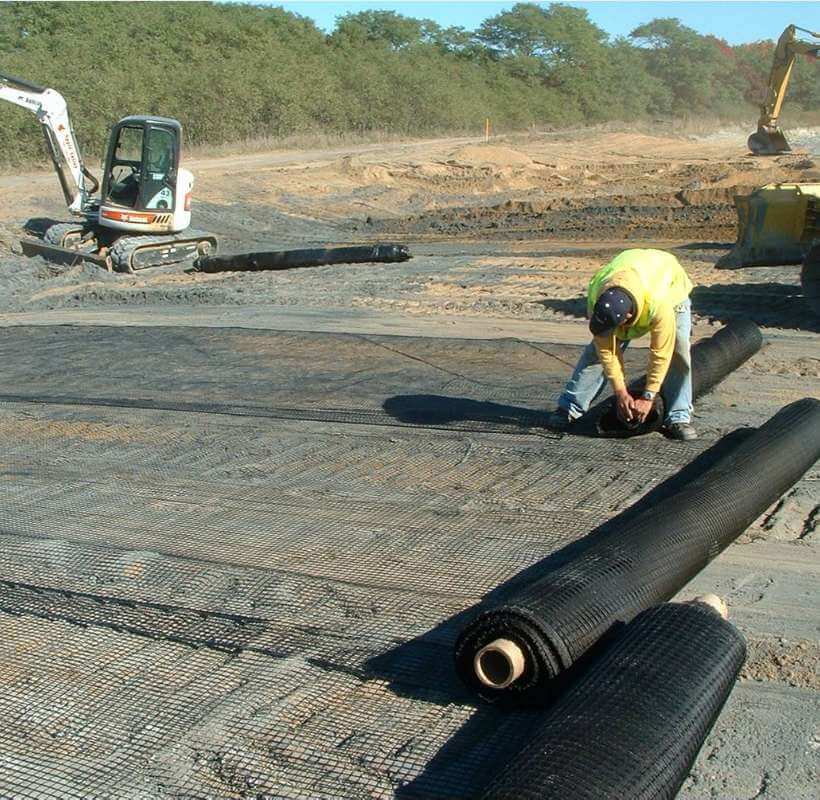Geogrid
What is a geogrid?
A geogrid is a two-dimensional geosynthetic material designed to provide tensile reinforcement for soil and aggregate layers in civil engineering projects. Geogrids are manufactured from high-tensile polymers, such as polyester, polyethylene, or polypropylene, and are characterized by a fixed aspect ratio with intersecting ribs and apertures, which refer to the voids between the junctions. The apertures enable contact with the surrounding soil or subgrade material and enhance its strength. Geogrids are important for load distribution, soil stabilization, and reducing deformations in the subgrade.
Types of geogrids
Geogrids come in the following types, each serving distinct applications:
Uniaxial geogrids
Uniaxial geogrids serve the purpose of providing reinforcement in a singular direction. The ribs of these geogrids are oriented longitudinally, thereby offering significant tensile strength along one axis. Such geogrids are commonly employed in applications that necessitate stability in a single direction, including:
- Retaining walls
- Steep slopes
- Embankments
StrataGrid™ uniaxial geogrid is engineered for maximum tensile strength, making it ideal for projects that require strong load-bearing reinforcement in one direction.
Biaxial geogrids
Biaxial geogrids are designed to provide tensile strength in two perpendicular directions: longitudinal and transverse. This bidirectional strength makes them highly suitable for applications requiring even load distribution and stability:
- Pavement reinforcement
- Base stabilization
- Railway track beds
StrataGrid™ Biaxial (SGB) geogrid is designed to perform better in applications requiring bidirectional reinforcement.


Applications of geogrids in civil engineering
Geogrids are widely used for various civil engineering applications, as they enhance the strength of soil and prevent settlement. They are mainly utilized in the following areas:
- Soil stabilization: Geogrids improve the load-carrying capacity of weak subgrades by confining soil particles within their apertures. This reduces soil movement, settlement, and surface deformation.
- Reinforced retaining walls: Geogrids play a significant role in building retaining walls and steep slopes. By providing tensile reinforcement, geogrids enable these structures to stand effectively under both vertical and lateral loads.
- Pavement and road reinforcement: Geogrids help distribute loads evenly in the base layer during road construction, preventing rutting and cracking of asphalt pavements. This also reduces the required thickness of the base and subbase layers, lowering construction costs.
- Embankment stabilization: Geogrids can be used to stabilize embankments, especially in soft soil sites and erosion-prone areas, by distributing loads and enhancing soil friction.
- Landfill liners and caps: In landfill applications, geogrids reinforce liner systems, preventing the escape of waste material. They also ensure that capping layers remain stable, ensuring long-term functionality.

Key benefits of using geogrids
Geogrids offer several advantages in civil engineering projects:
- Enhanced load distribution: Geogrids distribute loads over a broader area, reducing localized pressure and minimizing deformation.
- Improved soil stability: The lateral confinement provided by geogrids reduces soil movement and enhances overall strength.
- Cost savings: By reducing the thickness of subgrade and base layers, geogrids help lower construction costs.
- Durability: Geogrids made from high-tensile polymers are resistant to chemical and physical degradation, ensuring long-lasting performance.
- Erosion control: Geogrids minimize soil erosion in slopes and embankments, promoting long-term stability.
Materials used in geogrid manufacturing
Geogrids are primarily manufactured from polymers such as:
- Polyester (PET): Known for its high tensile strength and resistance to creep, polyester geogrids are commonly used in reinforcement applications.
- Polypropylene (PP): Polypropylene geogrids are lightweight, chemically resistant, and easy to install, making them suitable for various applications.
- Polyethylene (PE): These geogrids are preferred for their durability in harsh environmental conditions, such as chemically aggressive soils.
How do geogrids work?
Geogrids were invented for the purpose of soil stabilization in geotechnical engineering. They work to improve soil stability and resistance through a mechanical interlock, where aggregate material or soil penetrates the geogrid’s apertures, creating a strong bond. This mechanism is a function of soil-grid interaction that restrains the earth material and minimizes its movement. Three key factors affect the strength of the geogrid and the resulting stability: the thickness or size of the aperture, the thickness of the polyester or ribs, and junction strength. Choosing a geosynthetics manufacturer whose geogrid specifications meet your requirements is crucial, as they affect multiple soil properties, including shear strength, angle of repose, tensile strength, and load-bearing capacity. Geogrids serve two purposes: soil stabilization and soil improvement.
Soil improvement using geogrids
When using geogrids to improve soil (mechanically) for the subgrade or base, we typically apply one or more rolls of geogrids over aggregate or infill material to reduce pavement thickness or infill material costs. In this instance, the primary concern is to address settlement, load distribution, and soil containment.
Soil stabilization using geogrids
Where the goal is to prevent soil movement and stabilize the earth material, geogrids can be used horizontally, for example, in paved roads, railway track beds, landfills, or vertically for slope stabilization, foundation reinforcement, and embankment reinforcement.
Frequently asked questions about geogrids
What is the primary function of a geogrid?
The primary function of a geogrid is to provide tensile reinforcement for soil and aggregate layers, improving load distribution and stability.
How do geogrids differ from geotextiles?
Geogrids are primarily used for tensile reinforcement, while geotextiles are used for filtration, drainage, and separation.
Can geogrids be used in waterlogged areas?
Yes, geogrids are suitable for waterlogged areas as they allow better drainage and reduce the risk of soil settlement.
What factors should be considered when selecting a geogrid?
Key factors include tensile strength, aperture size, chemical resistance, and the type of application.
Geogrids play a crucial role in modern civil engineering by providing an efficient and cost-effective solution for soil stabilization and reinforcement. Their versatility, durability, and ability to improve load distribution make them indispensable in projects ranging from road construction to slope stabilization. By understanding their applications and benefits, engineers can leverage geogrids, such as StrataGrid™ uniaxial geogrid and StrataGrid™ Biaxial (SGB) geogrid, to build more sustainable and resilient infrastructure.
